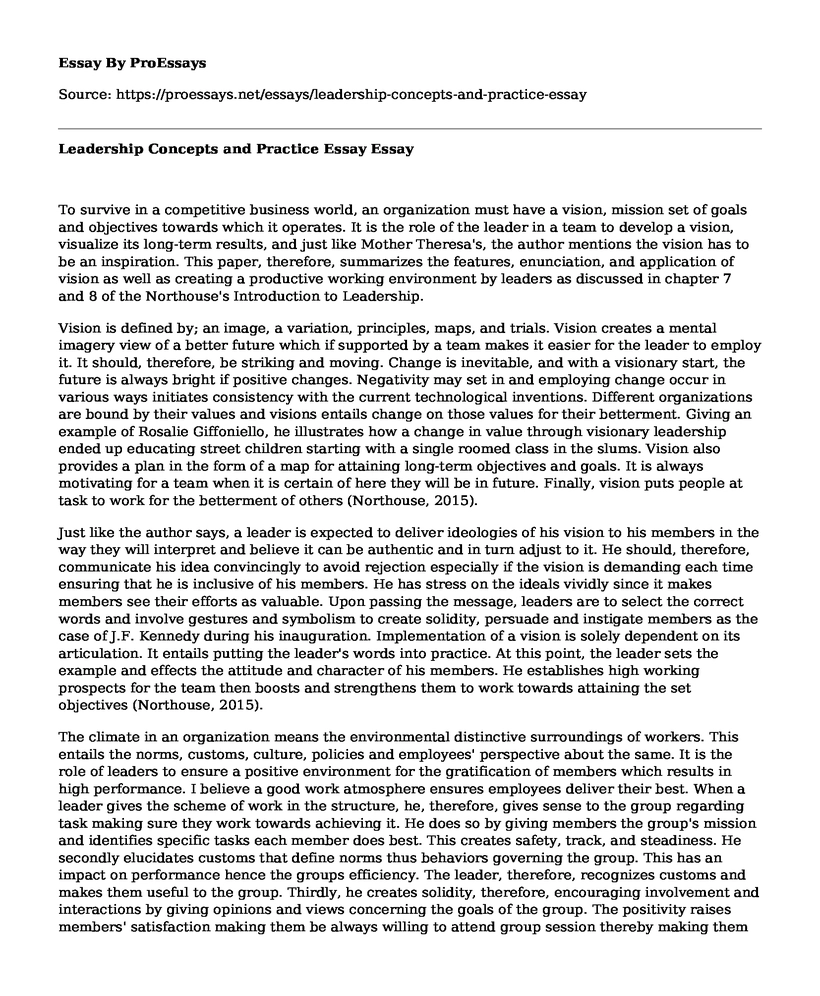To survive in a competitive business world, an organization must have a vision, mission set of goals and objectives towards which it operates. It is the role of the leader in a team to develop a vision, visualize its long-term results, and just like Mother Theresa's, the author mentions the vision has to be an inspiration. This paper, therefore, summarizes the features, enunciation, and application of vision as well as creating a productive working environment by leaders as discussed in chapter 7 and 8 of the Northouse's Introduction to Leadership.
Vision is defined by; an image, a variation, principles, maps, and trials. Vision creates a mental imagery view of a better future which if supported by a team makes it easier for the leader to employ it. It should, therefore, be striking and moving. Change is inevitable, and with a visionary start, the future is always bright if positive changes. Negativity may set in and employing change occur in various ways initiates consistency with the current technological inventions. Different organizations are bound by their values and visions entails change on those values for their betterment. Giving an example of Rosalie Giffoniello, he illustrates how a change in value through visionary leadership ended up educating street children starting with a single roomed class in the slums. Vision also provides a plan in the form of a map for attaining long-term objectives and goals. It is always motivating for a team when it is certain of here they will be in future. Finally, vision puts people at task to work for the betterment of others (Northouse, 2015).
Just like the author says, a leader is expected to deliver ideologies of his vision to his members in the way they will interpret and believe it can be authentic and in turn adjust to it. He should, therefore, communicate his idea convincingly to avoid rejection especially if the vision is demanding each time ensuring that he is inclusive of his members. He has stress on the ideals vividly since it makes members see their efforts as valuable. Upon passing the message, leaders are to select the correct words and involve gestures and symbolism to create solidity, persuade and instigate members as the case of J.F. Kennedy during his inauguration. Implementation of a vision is solely dependent on its articulation. It entails putting the leader's words into practice. At this point, the leader sets the example and effects the attitude and character of his members. He establishes high working prospects for the team then boosts and strengthens them to work towards attaining the set objectives (Northouse, 2015).
The climate in an organization means the environmental distinctive surroundings of workers. This entails the norms, customs, culture, policies and employees' perspective about the same. It is the role of leaders to ensure a positive environment for the gratification of members which results in high performance. I believe a good work atmosphere ensures employees deliver their best. When a leader gives the scheme of work in the structure, he, therefore, gives sense to the group regarding task making sure they work towards achieving it. He does so by giving members the group's mission and identifies specific tasks each member does best. This creates safety, track, and steadiness. He secondly elucidates customs that define norms thus behaviors governing the group. This has an impact on performance hence the groups efficiency. The leader, therefore, recognizes customs and makes them useful to the group. Thirdly, he creates solidity, therefore, encouraging involvement and interactions by giving opinions and views concerning the goals of the group. The positivity raises members' satisfaction making them be always willing to attend group session thereby making them unswerving. With time members integrate the norms and work within limits to achieve the group's goals eventually raising performance (Northouse, 2015).
Eventually, the leader generates and endorses guidelines for success. In a case study described by Larson and LaFarsto, the author describes six factors to be considered for essential functioning. A leader should, therefore, deliver to the team what is expected of them and tell them he expects outcomes. He then reviews the results acquired to gives truthful and direct response in turn analyses performance. Based on the review he then rewards the results attained. This keeps the members invigorated, and they feel appreciated (Northouse, 2015).
References
Northouse, P.G., (2015). Introduction to leadership: Concepts and practice. 3 (7-8)
Cite this page
Leadership Concepts and Practice Essay. (2022, Apr 04). Retrieved from https://proessays.net/essays/leadership-concepts-and-practice-essay
If you are the original author of this essay and no longer wish to have it published on the ProEssays website, please click below to request its removal:
- Case Study Example: Shell's Dependent Stakeholders
- Business Ethics Essay
- Emergency Management of "Deep Horizon" Event
- Disney and 21st Century Fox Companies Analysis Paper Example
- Essay Sample on Organizational Culture in Apple
- Essay Example on Pierre Omidyar: A Great Catalyst for Positive Change in Lives
- Tencent's Rise: Leadership, Change Management and Restructuring - Essay Sample







